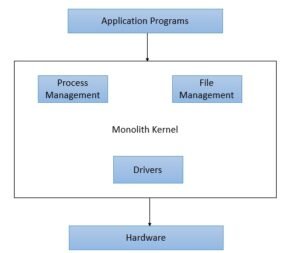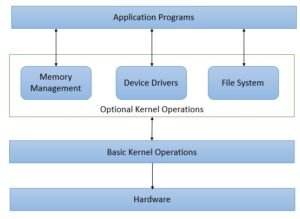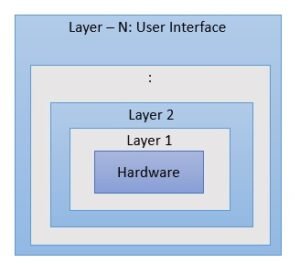OS Architecture: Monolithic, Microkernel, and Layered
Operating System architecture refers to the design structure of the OS—how its various components are organized, how they interact, and how system services are managed. Different architectures reflect different design philosophies and trade-offs in terms of performance, security, complexity, and scalability. Let’s explore three key OS architectures:
1. Monolithic Architecture
Monolithic OS is the most traditional and widely used architecture, where the entire operating system runs in a single layer (kernel space) and all modules (like device drivers, file systems, memory manager) are part of a large, single code base.
Characteristics:
- All core services are tightly integrated.
- Communication between components is fast, as they run in the same space.
- Adding or removing features requires recompiling the entire kernel.
Advantages:
- High performance due to direct interactions.
- Suitable for systems where speed is a priority.
Disadvantages:
- Difficult to maintain and debug.
- A single error can bring down the entire system.

2. Microkernel Architecture
In a Microkernel OS, only the most essential services (like memory management, inter-process communication, and basic scheduling) run in kernel space. All other services (like device drivers, file systems, and networking) run in user space as separate processes.
Characteristics:
- Core functions are kept minimal.
- Uses message-passing for communication between services.
- Strong separation between kernel and other components.
Advantages:
- More secure and stable—faults in user-space services don’t crash the kernel.
- Easier to update or replace parts of the system without rebooting.
Disadvantages:
- Message-passing can slow down performance.
- More complex to design and manage efficiently.

3. Layered Architecture
Layered OS is structured as a hierarchy of layers, where each layer has a well-defined role and communicates only with its adjacent layers. Lower layers provide services to higher ones, and higher layers rely on lower ones to perform system-level tasks.
Characteristics:
- Each layer is independent and self-contained.
- Higher layers use the services of the lower layers.
Typical Layering:
- Hardware
- Kernel
- Memory Management
- Device Drivers
- User Interface
Advantages:
- Modular and easy to debug or modify.
- Enhances maintainability and scalability.
Disadvantages:
- Can be slower due to layer-to-layer communication.
- Strict layering can be inflexible in some scenarios.

Summary
The architecture of an Operating System determines how efficiently it can manage resources, scale with hardware, and recover from faults. While Monolithic architecture favors performance, Microkernel prioritizes stability and security, and Layered architecture offers modularity and clarity. Choosing the right architecture depends on the system’s goals, use case, and performance requirements.